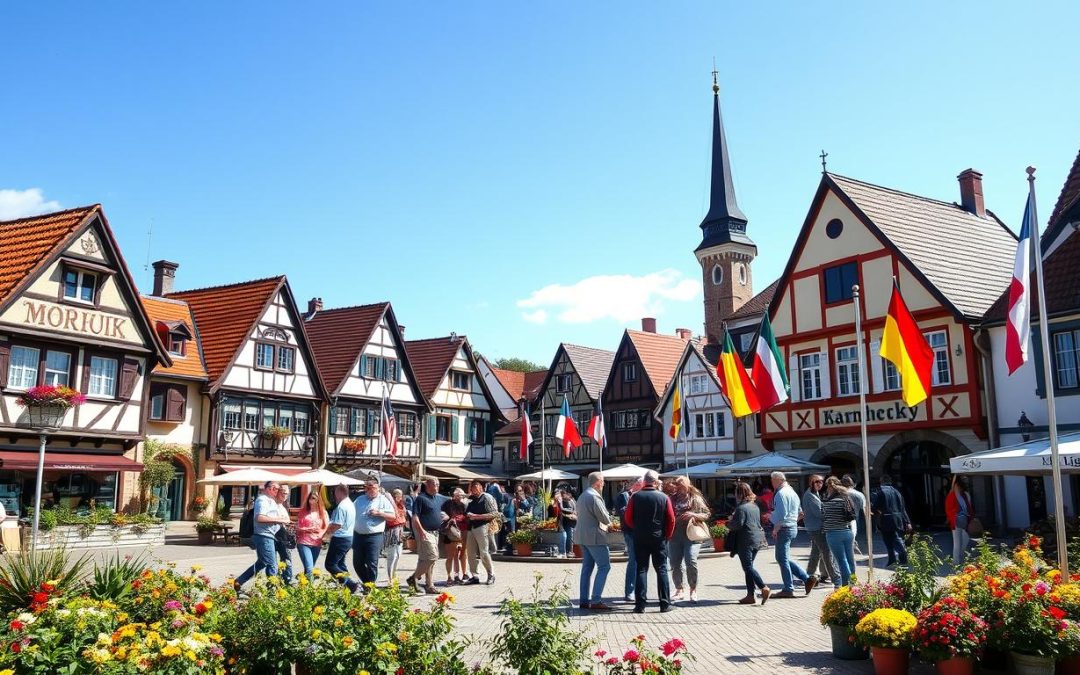Have you ever wondered how a single country can have so many languages and still feel united? Germany is a great example of this. It shows how language and culture can mix together beautifully.
In Europe, Germany has a unique mix of languages. While German is the main language, about 95% of people speak it. But there’s more to it. The country is also full of other languages, thanks to its diverse culture.
German is the official language in Germany. It’s used in government, schools, and everyday talks. But English is also very common, especially in cities. And many immigrant languages add to the country’s rich language scene.
Exploring Germany’s languages shows how they shape our lives. They influence how we talk, work, and understand each other. From big cities to small towns, Germany values all languages. This shows its open and welcoming nature.
Key Takeaways
- German is the official language spoken by 95% of the population
- English is widely used as a second language, especially in urban areas
- Immigrant languages like Turkish significantly contribute to language diversity
- Germany supports multilingualism through education and cultural policies
- Regional dialects play a crucial role in Germany’s linguistic identity
Understanding German as the Official Language
Exploring Germany’s language scene shows a rich mix. German is key to national identity, with 95% of people speaking it or its dialects first.
The language diversity in Germany is interesting. It shows how people communicate differently in various areas. Standard German, or Hochdeutsch, is the official language. But, local dialects add flavor to daily talks.
Standard German vs Regional Variations
Regional dialects are vital in Germany’s language world. Each area has its own language style, showing local culture. For example:
- Bavarian dialect is popular, with 45% of Bavarians using it daily
- Northern Low Saxon is an important minority language
- Dialects highlight the rich language history of German regions
Statistical Overview of German Speakers
The German language is widely spoken. Here are some interesting facts:
- 90% of homes mainly speak German
- Native German speakers: 95 million
- Non-native speakers: 80-85 million
Legal Status of German Language
German is an official language in several countries, like Germany, Austria, Switzerland, and Namibia. It’s more than a way to talk—it connects different cultures.
“Language is the road map of a culture. It tells you where its people come from and where they are going.” – Rita Mae Brown
Learning about German language shows a lively, changing system. It mirrors Germany’s diverse culture.
The Rise of English in Modern Germany
Germany’s language scene is changing fast, with English becoming key for talking to each other. In 2017, 81% of school kids were learning English first. This big change shows how education is adapting.
English is not just for school anymore. About 56% of people can speak English, especially in big cities. This shows Germany’s link to the world and its push for global talks.
Several things are making English more popular in Germany:
- Global business and industry
- More international school projects
- The impact of digital media and tech
- Jobs that need English skills
“English has become more than a foreign language in Germany—it’s a gateway to global opportunities.”
Young people in Germany are getting better at speaking English. A study found 45% of 18- to 29-year-olds speak English well. Only 15% of those over 55 can do the same.
| Language Metric | Percentage |
|---|---|
| Students Learning English | 81% |
| Overall English Speakers | 56% |
| Urban English Proficiency | 70% |
| Young Adults Fluent in English | 45% |
As English becomes more important in Germany, it’s changing how we talk in schools, work, and social life.
German Dialects and Regional Language Diversity
Germany is home to a wide range of languages, showing its deep cultural roots. The many regional dialects of German make communication in the country very interesting. With over 250 different dialects, Germany’s language diversity is complex and rich.
Exploring German dialects opens up a world of language. Each region has its own way of speaking, making Germany’s language scene very diverse.
Northern German Dialects
In Northern Germany, you’ll find Low German (Plattdeutsch). It has its own special features. Some key points include:
- Lack of second consonant shift found in High German
- Spoken in Northern Germany and parts of the Netherlands
- Significant differences from Standard German
Southern German Varieties
Southern German dialects are very complex. The Upper German dialects include:
- Alemannic
- Bavarian-Austrian
- Franconian
These dialects sound like different languages, with their own words and ways of speaking.
Central German Language Patterns
Central German dialects are also key to Germany’s language scene. The Moselle Franconian dialect, spoken by the Moselle River, shows the area’s language richness.
“Language is the road map of a culture. It tells you where its people come from and where they are going.” – Rita Mae Brown
| Dialect Group | Geographical Region | Unique Characteristics |
|---|---|---|
| Low German | Northern Germany | Lacks second consonant shift |
| Upper German | Southern Germany | Complex grammatical structures |
| Central German | Central Germany | Transitional dialect characteristics |
Even with efforts to standardize, these dialects are crucial for keeping Germany’s language heritage alive.
Minority Languages in Contemporary Germany
Germany’s language scene is more complex than many think. The country values linguistic diversity, beyond just German. It celebrates a variety of minority languages, showing off its rich cultural background.
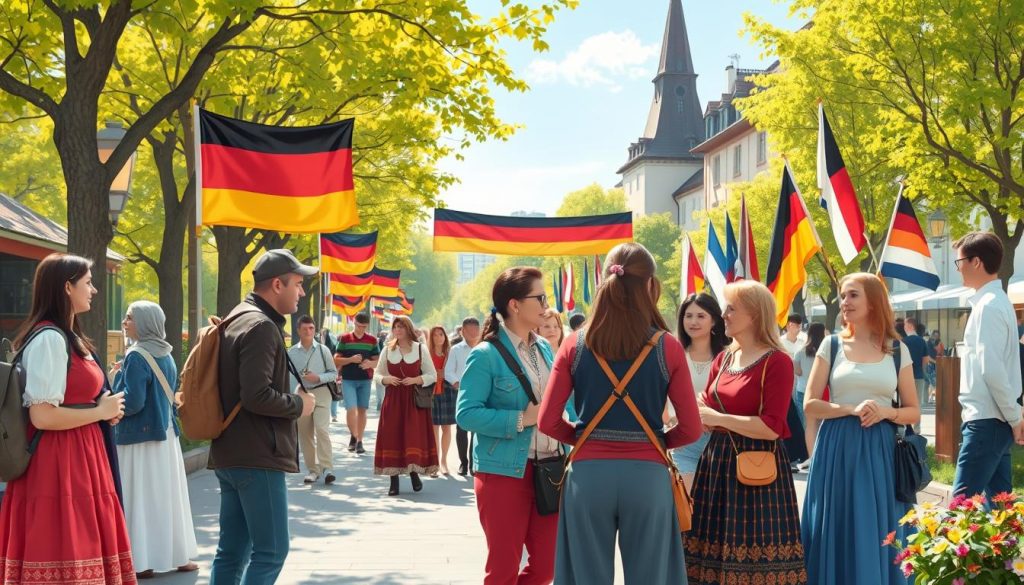
Looking into Germany’s minority languages, we find a colorful mix of languages. Some key ones include:
- Romani: Spoken by about 0.8% of the population
- Danish: With around 50,000 speakers
- North Frisian: A small but important language group
- Sorbian languages: Upper and Lower Sorbian, with about 60,000 speakers
“Language is the road map of a culture. It tells you where its people come from and where they are going.” – Rita Mae Brown
These minority languages are more than just old traditions. They are active ways of talking and connecting. The German government works to keep these languages alive, seeing their value in culture.
| Minority Language | Estimated Speakers | Region of Prominence |
|---|---|---|
| Romani | 70,000-105,000 | Nationwide |
| Danish | 50,000 | Northern Germany |
| Sorbian | 60,000 | Eastern Germany |
| Frisian | 60,000-70,000 | Northern Coastal Regions |
Even though these languages are spoken by a small part of the population, they are vital. They help keep Germany’s cultural diversity alive. Protecting these languages shows Germany’s deep respect for its cultural and linguistic variety.
Immigration’s Impact on Language Diversity
Germany’s language scene has changed a lot because of immigration. People from different places have made the country’s language world more colorful. Now, there’s more to talk about than just German.
Germany’s language mix is complex. It shows how immigrant groups have added to the languages spoken here. These groups bring their own cultures and languages, changing how people talk and interact.
Turkish Language Communities
Turkish immigrants are a big part of Germany’s language scene. About 1.8% of the people speak Turkish. They have built strong cultural ties in cities like Berlin, Hamburg, and Frankfurt.
- Concentrated primarily in urban centers
- Strong cultural preservation efforts
- Significant impact on local social structures
Russian-Speaking Population
Russian speakers make up about 2.6% of Germany’s people. They are mostly ethnic Germans from Eastern Europe and new immigrants. They’ve added to Germany’s cultural and language richness.
“Language is the roadmap of a culture. It tells you where its people come from and where they are going.” – Rita Mae Brown
Other Immigrant Languages
Germany also has many other immigrant languages. For example:
- Kurdish (approximately 0.3%)
- Arabic
- Greek
- Italian
- Polish
These languages add to Germany’s cultural mix. They show the country’s dedication to diversity and understanding different cultures.
Germany: Official and Widely Spoken Languages
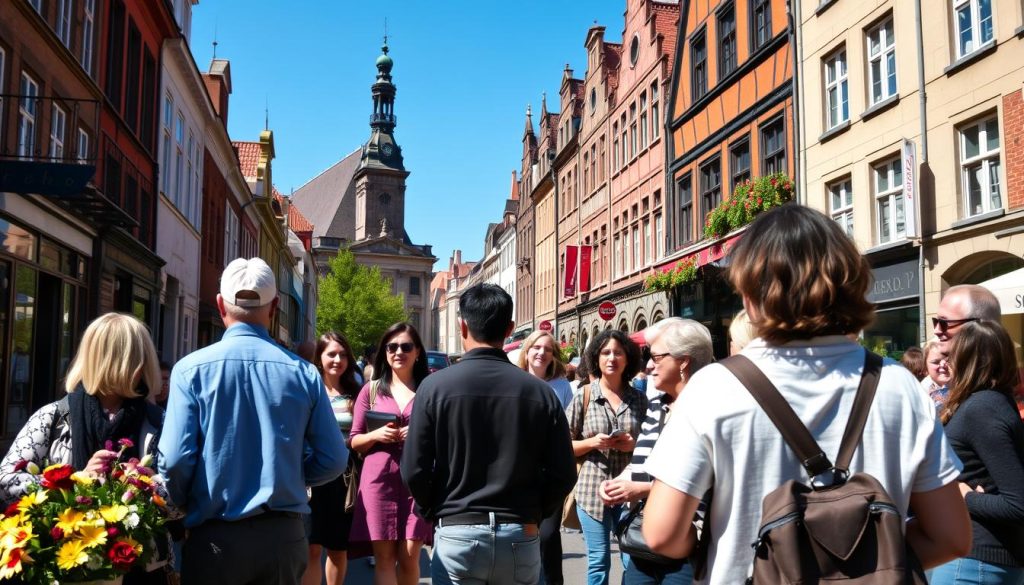
Exploring Germany’s languages reveals a rich mix. German is the official language, used by most people. It has about 100 million native speakers, making it the country’s main language.
Let’s look at Germany’s language profile:
- Standard German: Primary official language
- English: Widely spoken second language
- Immigrant languages: Reflecting cultural diversity
Germans are skilled in languages. About 67% of the population speaks at least one foreign language. English is the most common, with 56% of Germans speaking it well.
“Language is the road map of a culture. It tells you where its people come from and where they are going.” – Rita Mae Brown
Germany also has a variety of other languages:
- Turkish: Spoken by 1.8% of the population
- Russian: Represented by 5% of residents
- French: Spoken by 15% of Germans
Germany’s language mix shows its diverse culture. Immigrant languages enrich the country’s communication. Knowing many languages is key in Germany’s society, for work, school, and everyday life.
Language Education in German Schools
Germany is serious about getting students ready for the world. It focuses on teaching many languages. This makes learning German and being bilingual important goals.
The German school system has a detailed plan for teaching languages. It starts early and keeps improving students’ language skills as they grow.
Foreign Language Requirements
Learning a foreign language is a big deal in Germany. Kids start learning their first foreign language in the third grade. English is the most popular choice.
- English is introduced around age eight
- Students learn multiple foreign languages throughout their education
- By secondary school, most students study at least two foreign languages
Bilingual Education Programs
Germany loves bilingual education for learning languages. These programs teach German and other languages like English, French, and Spanish together.
| Language Program Type | Languages Offered | Student Participation |
|---|---|---|
| Bilingual Kindergartens | German, English, French | Growing annually |
| School Bilingual Programs | German + Multiple Languages | Over 15% of schools |
“Language learning is the key to understanding different cultures and perspectives.” – German Education Expert
Germany’s focus on language education is preparing a multilingual generation. They will be ready to connect with the world.
Historical Evolution of Language Policies
Germany’s linguistic journey is filled with interesting changes in language policies. The split between East and West Germany greatly influenced language education and communication during the Cold War.
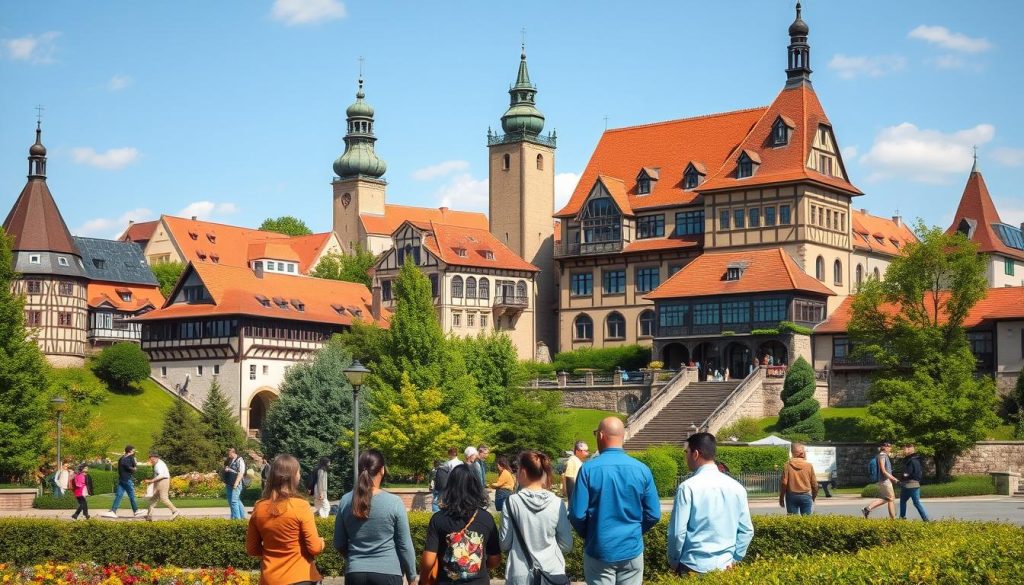
In the German Democratic Republic (1949-1990), Russian was the main second language. Schools in East Germany worked hard to teach Russian. This showed the strong ties with the Soviet Union.
“Language is the road map of a culture. It tells you where its people come from and where they are going.” – Rita Mae Brown
On the other hand, West German schools focused on English and French. This showed a different view towards Western European countries.
- East Germany: Russian as primary second language
- West Germany: English and French as preferred languages
- Post-reunification: Shift towards English dominance
After Germany was united in 1990, language policies changed a lot. English became the top foreign language in Germany. This change followed global trends and economic ties.
| Period | Dominant Second Language | Political Context |
|---|---|---|
| 1949-1990 (East Germany) | Russian | Soviet Influence |
| 1949-1990 (West Germany) | English, French | Western European Orientation |
| Post-1990 | English | Global Communication |
The changes in Germany’s language policies show how politics, culture, and language are linked. Knowing this history helps us see how language has evolved in German society.
Protected Regional Languages Under European Charter
Germany has made big steps in protecting minority languages. It signed the European Charter for Regional or Minority Languages on 16 September 1998. This shows the country’s commitment to keeping languages and cultures alive.
In Germany, many regional languages are recognized. These languages have a long history in different states. Some of these languages include:
- Danish (in Schleswig-Holstein)
- Low German (Plattdeutsch)
- North Frisian
- Saterland Frisian
- Upper and Lower Sorbian
- Romani
Implementation and Support Measures
Each language gets special support. For example, Schleswig-Holstein’s laws protect minority languages. This means people can speak Danish, Frisian, or Low German without extra costs.
“Language is the road map of a culture. It tells you where its people come from and where they are going.” – Rita Mae Brown
Regional Language Rights
The European Charter helps keep languages alive. Germany has set up 35 actions for each language. This ensures these languages stay vibrant for future generations.
Germany’s language policies are getting better. It sees each language as a treasure of cultural heritage. The country is dedicated to preserving these languages.
Business Communication and Language Preferences
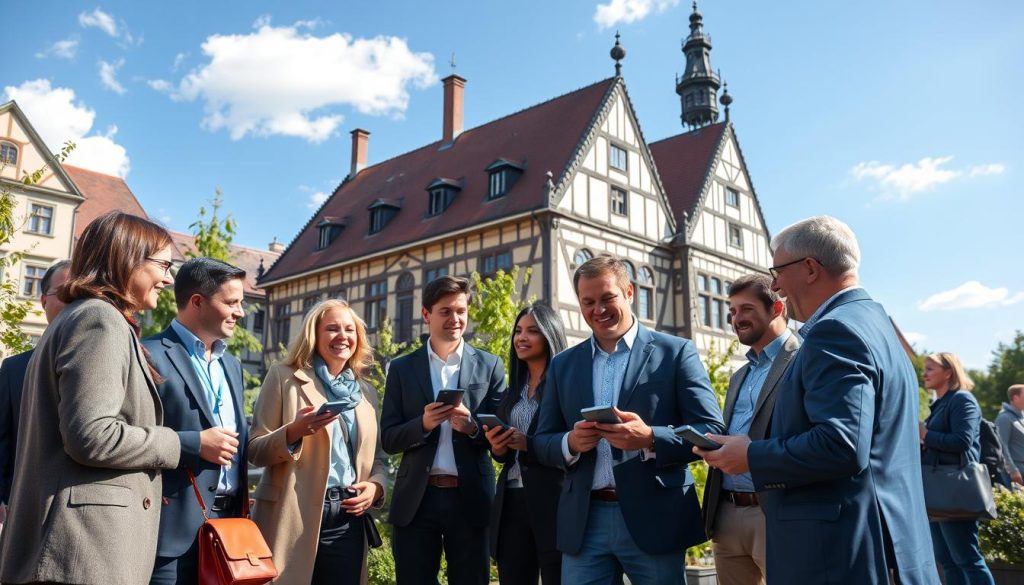
In the world of German business, you’ll find a mix of old and new ways of talking. The German language is still key, but English is also very important in many companies.
Here are some important points about language in German business:
- English is becoming more like the lingua franca in big international companies
- Big companies mostly use English for talking across the globe
- Fields like tech and special areas still use German for clear talk
Being good at both German and English is a big plus for jobs. Companies want people who can easily switch between languages. This shows Germany’s role in the world business scene.
“Language is the passport to a culture’s professional world” – Unknown German Business Consultant
Different industries have different language needs. For example, tech and startups mostly use English. But, old industries like manufacturing and engineering still need German.
| Industry | Primary Business Language | Language Proficiency Requirement |
|---|---|---|
| Technology | English | High |
| Manufacturing | German | Advanced |
| Finance | Bilingual | Excellent |
Knowing about these language details can really help in business in Germany. Good language skills show you’re professional and respect the culture.
Cultural Impact of Multilingualism in Germany
Germany’s language scene is full of cultural connections and ways to communicate. The mix of languages has made social interactions richer. Now, many languages live together and grow.
In Germany, speaking more than one language is not just common. It’s a key to social inclusion and understanding cultures. With 67% of Germans speaking at least one foreign language, the country has found a unique way to talk to each other.
Integration Through Language
Language is a bridge for different groups in Germany. Important steps for integration include:
- Comprehensive language support programs
- Integration courses for immigrants
- Bilingual education initiatives
“Language is the road map of a culture. It tells you where its people come from and where they are going.” – Rita Mae Brown
Preservation of Linguistic Heritage
Germany works hard to keep its language diversity alive. It protects regional languages and minority dialects. The effort goes beyond keeping them alive to celebrating the variety of languages.
- Recognition of minority languages like Sorbian and Low German
- Support for over 200 bilingual schools nationwide
- Cultural programs promoting linguistic awareness
By embracing multilingualism, Germany is building a society that’s open and connected. Language becomes a powerful tool for understanding and sharing cultures.
Conclusion
Your journey through Germany’s linguistic landscape shows a world full of communication. The German language, with over 135 million speakers, is a symbol of cultural identity. Germany’s language diversity goes beyond German, showing a mix of native and immigrant languages.
In Germany, language is unique. While 95% speak German, the country values speaking multiple languages. About 67% of Germans speak at least one foreign language, with 27% speaking two. This shows Germany’s dedication to global communication and understanding.
The languages spoken in Germany tell a story of migration and global connection. Turkish, Kurdish, and English are becoming more common. This shows Germany’s ability to welcome and adapt to different languages.
Reflecting on Germany’s language journey, you see a balance. The country values its language heritage while embracing global communication. Germany’s language approach shows its openness, adaptability, and commitment to understanding the world through communication.
The above is subject to change.
Check back often to TRAVEL.COM for the latest travel tips and deals.
Here are some Tours & Sightseeing suggestions that might pique your interests!
